Big as the Super Bowl: A Basic Introduction to Football (Oops, I mean American Football) 🏈
What’s Going On Out There? A Beginner’s Guide to American Football
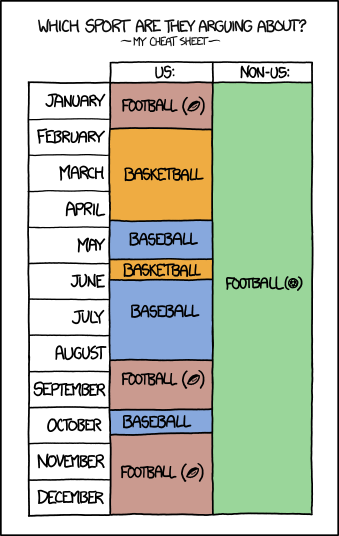
Image Source: XKCD
Introduction: Touchdown?
“Touchdown!” I remember shouting with everyone else during my first homecoming in college as I watched Dartmouth demolish Yale in a 42-10 win. I didn’t fully understand the sport. Still, I knew that when a player in green managed to get the ball into the Yale end zone, it was a touchdown.
At the time, I figured that while I didn’t quite grasp the rules, I enjoyed all the fanfare surrounding American football (I’ll mostly call it “football” from now on for ease—I know, I know, the Nigerian in me is resisting this). The energy was infectious, and I wanted to learn how to play. I casually joked about it over the phone with my mom. Naturally, she showed great concern, reminding me to focus on the real reason I went to school and not get caught up in a sport as dangerous as football.
Speaking of interesting encounters between Africans like me and their mums, my friend Chukwuka recently wrote a brilliant article about “African Mom Jokes” and how they can sometimes go too far, reinforcing harmful stereotypes and distorting reality. In his piece, he calls for more nuanced and respectful portrayals of African mums in media, especially in short-form comedy videos. It’s brilliant writing, and you can read it here.
My curiosity about football faded as schoolwork piled up, forcing me to focus and abandon my pipe dream of a football career. So, as you might have guessed, I never thoroughly learned the sport. But a few months ago, a friend and mentor at work asked if I’d like to join her flag football team. She knew I could run and figured I’d pick up the rest of the skills. I accepted. I can finally say, Mama, I made it—even if I play a much less intense version of the sport. You can read about my adventures during my first season in my 2024 reflection blog post.
My first game? All I had to do was run and chase people—that part was easy. But I was still pretty clueless. So, over the next week, I read several articles, watched countless videos, and learned a lot about football—from its history to the leagues, the teams, the legends, and even the NFL’s “socialist” revenue-sharing model.
As we approach Super Bowl LIX, I know you might be interested in many random things. If you’re a Swiftie, you might only be looking forward to seeing her dance and cheer on her boyfriend. Maybe you’re hoping for an electrifying halftime performance from Kendrick Lamar, given his incredible year and recent Grammy wins. Or perhaps you want to hang out with friends, bring beer (or not—mummy, I know you’re reading this), and watch the ads.
But if you’re interested in the game itself—how it works, how teams score, what the rules are—this blog post should help. After reading it, I suspect you won’t be as lost as I was at the many football games I attended in college. Keep in mind that the focus is exclusively on the game. Ultimately, I will link plenty of resources to learn more about other fascinating aspects of football.
And if you happen to be in Seattle and want to watch the Super Bowl with a friendly group, I’m hosting a watch party—feel free to contact me for more details.
The Basics of American Football
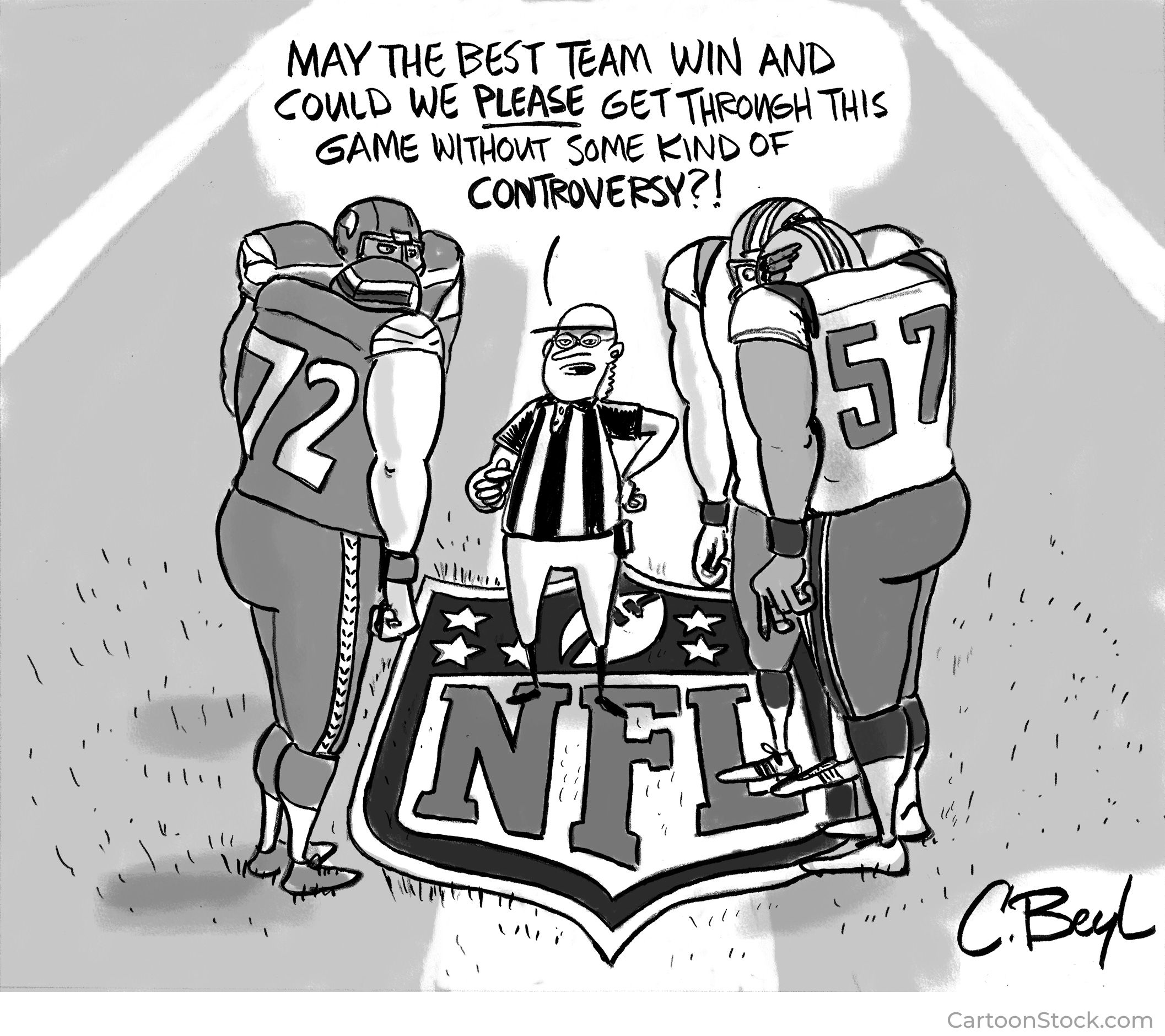
Image Source: Cartoon Stock
American football is one of those sports that looks like absolute chaos until you understand the method behind the madness. Big guys in pads crash into each other, the game stops every few seconds, and yet, millons of people swear by it. If you’re here, you’ve probably wondered: What is happening? Well, at its core, football is a strategic battle for territory, where teams fight (not literally, though sometimes it feels like it) to advance the ball down the field and score points. Once you grasp the fundamentals, though, everything- even the weird rules- starts making sense.
The Goal: Move the Ball, Score Points
The entire point of football is to get the ball (or egg, as some of my friends call it—it’s actually an oblong sphere called “The Duke.” All official balls are handcrafted by Wilson Sporting Goods) into the opponent’s end zone and score more points than the other team. The offense (the team with the ball) has four tries or plays—called downs—to move at least 10 yards. If they succeed, they reset to another four downs and keep advancing. If they fail, they either punt the ball (kick it downfield to push the opponent farther from their end zone) or go for it on fourth down and risk turning it over. Meanwhile, the defense is there to disrupt, tackle, and take the ball back.
The points come in a few flavors:
- Touchdown (6 points): Run or catch the ball in the opponent’s end zone.
- Extra Point (1 or 2 points): After a touchdown, the team can kick for 1 point or run a short play to get the ball into the opponent’s end zone for 2 points.
- Field Goal (3 points): Sometimes, a team gets close to the end zone but can’t score a touchdown—maybe the defense is too strong, or there’s not enough time left for more plays. In these situations, the team can kick the ball through the uprights for three points rather than risking a turnover on fourth down.
- Safety (2 points): Rare but exciting, this occurs when the defensive team forces the offense into their own end zone. This can happen in a few ways:
- The offensive ball carrier is tackled in their own end zone.
- A fumble or bad snap causes the ball to roll out of the back of the offense’s end zone.
- The quarterback commits intentional grounding in the end zone (throws the ball away under pressure with no receiver nearby).
- A blocked punt or kick bounces back into the end zone and goes out of bounds.
When a safety occurs, the defense is awarded 2 points, and the team that gave up the safety must kick the ball away from their 20-yard line, handing possession to the opponent.
The Field: A 100-Yard Chessboard
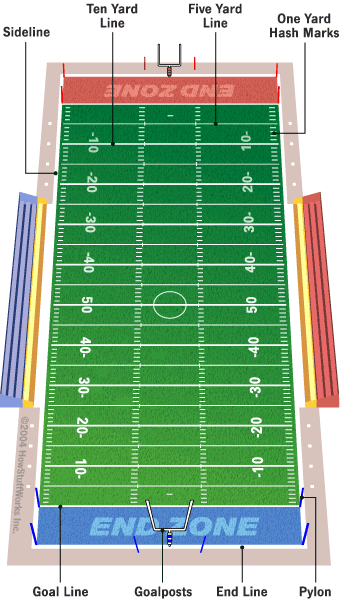
Image Source: How Stuff Works
The game is played on a 100-yard field (plus two 10-yard end zones). Every 10 yards is marked with bold white numbers - 10, 20, 30, all the way to the 50-yard line at the center of the pitch. In metric system, 10 yards is about 9.14 meters. The ball’s position dictates where the next play starts, and there are lighter 5-yard lines and tiny white hash marks to ensure precise placement. Finally, the big yellow goalposts are where kickers (more on them later) become heroes or villains.
The Game Flow
Football is a game of constant shifts between offense, defense, and special teams:
- Offense: The unit trying to score, led by the quarterback (think of them as the team’s general).
- Defense: The squad trying to stop the offense—tackling, intercepting passes, and causing chaos.
- Special Teams: The often-overlooked unit handling kickoffs, punts, and field goals.
Every game consists of four quarters (15 minutes each) plus halftime. It starts with a kickoff, and from there, teams trade possessions, moving the ball by either running (carrying the ball) or passing (throwing it downfield).
The offense loses possession when there’s a turnover, which can happen in a few ways:
- Interceptions: When a defensive player catches the quarterback’s pass.
- Fumbles: When the ball carrier loses control, the defense recovers.
- Turnover on Downs: When a team fails to gain 10 yards and doesn’t punt, handing the ball to the opponent.
Teams on defense can also gain an advantage through sacks, which means tackling the quarterback behind the line of scrimmage before they can throw the ball. Sacks can cause a loss of yardage, kill offensive momentum, or even lead to a turnover.
Penalties and Game Management
Referees throw yellow flags for rule violations, pushing teams forward or backward. Some common penalties include:
- Offsides and False Starts: Jumping ahead before the play begins.
- Holding: Illegally grabbing an opponent.
- Pass Interference: Preventing a receiver from catching the ball.
- Personal Fouls: Late hits or unnecessary roughness (yes, that’s a thing in football).
Teams strategically use timeouts, the two-minute warning, and clock management to control the pace of the game. If time runs out and the score is tied? Overtime. And trust me, the NFL has robust rules for handling overtime, which you can read about here.
Now that we understand the basics, let’s examine positions and player roles—because knowing who does what is just as important as understanding how the game flows.
Positions and Roles
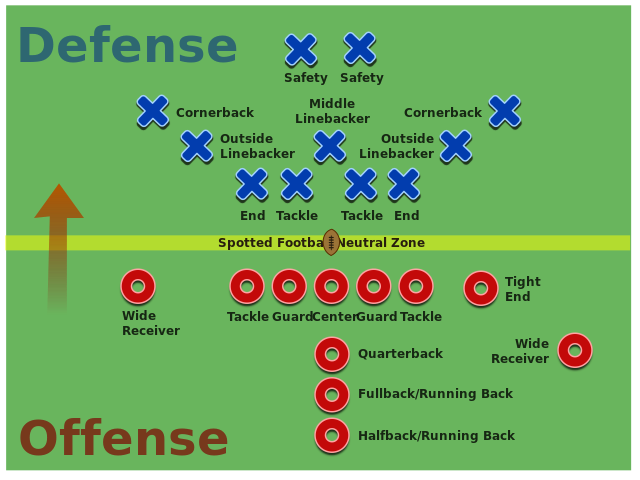
Image Source: The Shakerite
As we’ve learned initially, teams play offense or defense in football. Similarly, the positions and roles are divided into offensive and defensive positions, each contributing distinctly to helping their team gain an advantage on the field.
Offensive Positions
The offense’s primary objective is to advance the ball down the field and score points. The 11 offensive players are divided into two main groups: the offensive line and the backs and receivers.
Offensive Line
The offensive line (O-line) consists of five players whose primary responsibility is to protect the quarterback and create lanes for the running back.
- Center (C): Snaps the ball to the quarterback at the start of a play and immediately gets to work blocking defenders. Often, the center is the brain of the O-line, calling out adjustments to plays based on the defense’s setup.
- Guards (LG/RG): Positioned on either side of the center, they block defensive players, opening holes for the running back and keeping pass rushers away.
- Tackles (LT/RT): Lining up outside the guards, tackles protect the edges. The left tackle is crucial because they guard the quarterback’s blind side (think The Blind Side movie). They must be quick on their feet, strong, and highly skilled to hold off elite pass rushers.
Backs and Receivers
These players are responsible for advancing the ball through running and passing plays.
- Quarterback (QB): The team’s leader, the play-caller, and often the player that gets all the credit (and all the blame) after plays. The quarterback receives the ball from the center and can pass, handoff, or run the ball. They read the defense and may change plays at the line of scrimmage, a process known as calling an audible.
- Running Backs (RB): Typically positioned behind the quarterback, running backs primarily carry the ball on running plays but can also catch passes. The main types are:
- Halfback (HB): Usually the primary ball carrier, known for speed and agility.
- Fullback (FB): Generally larger and stronger, fullbacks lead block for the halfback and occasionally carry the ball in short-yardage situations.
- Wide Receivers (WR): These players line up near the sidelines and are the primary targets for passing plays. They run specific routes to get open for passes and may also block running plays.
- Tight End (TE) (Fun fact: This is the position that Taylor Swift’s boyfriend, Travis Kelce, plays, and that the popular sports media personality and NFL Hall of Fame inductee, Shannon Sharpe, played). Positioned next to the offensive line, tight ends serve dual roles as blockers and pass-catchers. Their versatility makes them valuable in both the running and passing games.
Defensive Positions
The defense’s primary objective is to prevent the offense from scoring by tackling ball carriers, defending against passes, and creating turnovers.
Defensive Line
These players line up directly on the line of scrimmage and engage the offensive line. They are the first line of defense.
- Defensive Tackles (DT): Located at the center of the defensive line, their primary goal is to stop running plays up the middle and pressure the quarterback on passing plays.
- Defensive Ends (DE): Positioned on the edges of the defensive line, they are usually quick and strong and attempt to contain plays by rushing towards the quarterback (sacks, baby!) and stopping outside runs.
Linebackers
Linebackers stand behind the defensive line and are versatile players involved in both run defense and pass coverage.
- Middle Linebacker (MLB): Often considered the “quarterback of the defense,” the MLB directs defensive alignments. It is heavily involved in stopping the run and covering short to intermediate pass routes.
- Outside Linebackers (OLB): Depending on the defensive scheme, OLBs may focus on covering receivers, supporting run defense, or blitzing the quarterback.
Defensive Backs
Also known as the secondary, these players focus on defending against passing plays and providing support on running plays.
- Cornerbacks (CB): Typically covering the offense’s wide receivers, cornerbacks aim to prevent successful passes by deflecting or intercepting the ball.
- Safeties: Positioned deeper in the defensive backfield, safeties provide a last line of defense against deep passes and runs.
- Free Safety (FS): The last line of defense, often patrolling deep downfield to prevent big plays.
- Strong Safety (SS): A hybrid linebacker-safety who helps cover tight ends and running backs in passing situations.
Special Teams
Special teams units handle all kicking plays, including kickoffs, punts, field goals, and extra points. Players on special teams have specialized roles that are crucial in determining field position and scoring opportunities.
- Kicker (K): Responsible for kickoffs, field goals, and extra point attempts.
- Punter (P): Handles punts, aiming to pin the opposing team deep in their own territory.
- Long Snapper (LS): Specializes in snapping the ball over longer distances, typically for punts and field goal attempts.
- Kick Returner (KR) and Punt Returner (PR): Tasked with catching kickoffs and punts, respectively, and advancing the ball as far as possible to set up a favorable field position.
For a visual explanation of these positions and their roles, you might find this video helpful: SPORTS 101 // Guide to American Football Positions
Strategies and Tactics
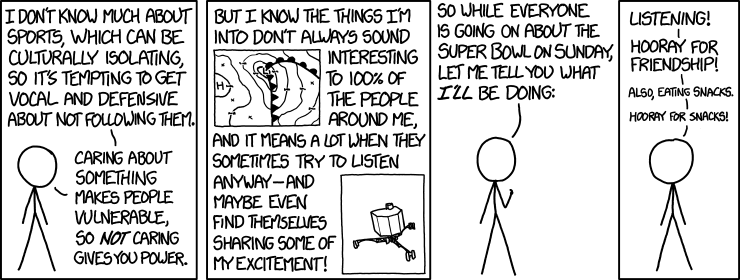
Image Source: XKCD
Football isn’t just about brute strength and speed; it’s a complex chess match where strategy and tactics play pivotal roles. Coaches and players meticulously plan and execute plays to outmaneuver their opponents, making the game as intellectually engaging as it is physically demanding. Let’s delve into the strategic elements that define this sport.
Offensive Strategies
The offense aims to advance the ball and score points, employing various strategies to keep the defense off balance.
1. Play Calling and Game Planning
Before each game, teams develop a game plan to exploit the opponent’s weaknesses and leverage their own strengths. This plan includes a selection of plays designed for various situations, such as short-yardage gains, long-distance passes, or red-zone scoring opportunities. Coaches script the opening plays to set the tone and gather information on the defense’s tendencies.
2. Formations and Personnel Packages
Offensive formations dictate the alignment of players on the field. Common formations include:
- I-Formation: Features a fullback and a halfback lined up directly behind the quarterback, ideal for powering running plays.
- Shotgun Formation: This formation positions the quarterback several yards behind the center, providing a better vantage point for passing plays.
- Singleback Formation: Utilizes a lone running back, allowing for a balanced attack with multiple receiving options.
Personnel packages refer to the combination of running backs, tight ends, and wide receivers on the field. For example, a “21” personnel package includes two running backs and one tight end. Varying these packages keeps the defense guessing and can create mismatches.
3. Passing vs. Running Plays
Balancing passing and running plays is crucial. A strong running game can force the defense to commit more players to the line of scrimmage, opening up opportunities for play-action passes. Conversely, an effective passing attack can spread the defense, creating running lanes.
4. Tempo and No-Huddle Offense
Altering the tempo of play can disrupt the defense’s rhythm. A no-huddle offense, where the team quickly lines up and executes plays without huddling, can tire defenders and limit their ability to substitute players, potentially exploiting mismatches.
Defensive Strategies
The defense aims to prevent the offense from advancing the ball and scoring, using various schemes and tactics to counter offensive plays.
1. Defensive Alignments and Formations
Defensive formations are designed to counter specific offensive strategies. Common alignments include:
- 4-3 Defense: Four defensive linemen and three linebackers, providing a balanced approach to stopping both the run and the pass.
- 3-4 Defense: Three defensive linemen and four linebackers, offering greater flexibility in blitz packages and pass coverage.
2. Man-to-Man vs. Zone Coverage
In pass defense, teams employ:
- Man-to-Man Coverage: Each defender is responsible for covering a specific offensive player, allowing for tight coverage but susceptible to pick plays.
- Zone Coverage: Defenders cover designated areas of the field, which can be effective against passing attacks but may leave gaps if not executed properly.
3. Blitzing
A blitz involves sending additional defenders, such as linebackers or defensive backs, to pressure the quarterback. While this can lead to sacks or hurried throws, it also leaves fewer players in coverage, increasing the risk of big plays by the offense.
4. Turnover Creation
Defenses aim to create turnovers through interceptions and forced fumbles. Strategies include disguising coverages to confuse the quarterback and employing aggressive tackling techniques to dislodge the ball.
Special Teams Strategies
1. Kickoff and Punt Coverage: The objective is to limit the opposing team’s return yardage. This involves strategic kick placement and disciplined coverage lanes to corral the returner.
2. Return Strategies: Return teams design blocking schemes to create lanes for the returner, aiming to gain an advantageous field position or score. Decisions on whether to attempt a return or signal for a fair catch are based on factors like hang time and coverage speed. Keep in mind, however, that the NFL regularly changes the rules of the game to keep things fresh and interesting. Hence, this information might be outdated, especially given the recent change to the kickoff rules.
3. Field Goal and Punt Fakes: Occasionally, teams will attempt fake field goals or punts to catch the defense off guard, aiming to convert a first down or score. These high-risk, high-reward plays are typically used in critical situations.
In-Game Adjustments
Football is dynamic, and successful teams make real-time adjustments based on the game’s flow.
1. Halftime Adjustments: Coaches analyze first-half performance, identifying what’s working and what’s not. They may alter their game plan, adjust play-calling tendencies, or implement new strategies to exploit observed weaknesses in the opponent.
2. Audibles: Quarterbacks have the authority to change the play at the line of scrimmage based on the defensive alignment. This ability to “call an audible” allows the offense to adapt to unexpected defensive strategies.
3. Clock Management: Managing the game clock is a critical strategic element, especially in close games. Teams may use timeouts, hurry-up offenses, or deliberate slow play to control the clock.
Understanding these strategies provides a deeper appreciation for the complexity and excitement of American football. It’s a game where every decision can influence the outcome, making it a thrilling spectacle for fans and a challenging endeavor for players and coaches alike. To understand more of the strategy details you might find these videos and resources helpful: Football Plays, Positions, Strategy & Tactics for Beginners, Smart Football, Breakdowns by Brett Kollmann.
Conclusion
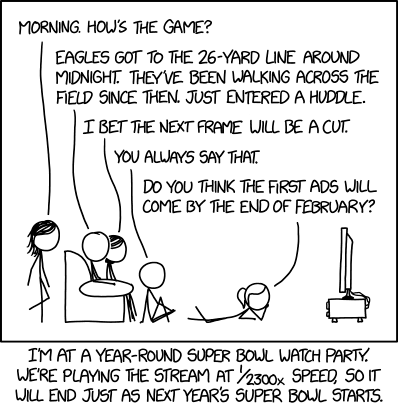
Image Source: XKCD
We’ve covered a lot—from a bit about football rules to the positions, strategies, and tactics that make it all make sense. If your brain is feeling overloaded, that’s normal. Football is a live-action strategy game with 300-pound linemen and commercial breaks every five minutes.
The next time you watch a game, you’ll know why everyone yells at the TV. You’ll recognize when a quarterback calls an audible, when a defense is setting up for a blitz, and when a kicker is probably about to ruin someone’s night. Maybe you’ll even impress your friends by casually explaining what a Cover 2 defense is (make sure to say it with confidence).
And if none of this has convinced you that football is fantastic, well—there are still the halftime show, the snacks, and the ads, so you’ve got something to look forward to.
Now, grab your wings, find a comfy seat, and enjoy the Super Bowl madness or just the halftime show. And if you still don’t get what’s happening? Just cheer when everyone else does. Trust me, it works. 🏈😂
References and Resources to Learn More
- What’s Actually Going On Out There? A Beginner’s Guide to American Football
- A Beginner’s Guide to American Football (NFL); rules, regulations, divisions & more
- NFL Throwback: How EVERY Team Got Its Name & Identity!
- The Entire History of the NFL
- How the NFL used ‘socialism’ to get rich
- The ENTIRE History of the Super Bowl!
- The OFFICIAL History of NFL Rules!
- Rules Of American Football EXPLAINED FOR BEGINNERS
- Rookie’s Guide
- SPORTS 101 // Guide to American Football
- Learn American Football in 5 Minutes
- What are the rules of American football? How does NFL work?
- NFL Rulebook
- [Quick Guide] What are the rules of football?
- A Beginner’s Guide to American Football
- Understanding American Football and Soccer
- Offensive and defensive football positions explained: What are they and why are there two different teams
- Football (American)
- How to Understand NFL Lingo, Part 1 of 3
- How to Understand NFL Lingo, Part 2 of 3
- How to Understand NFL Lingo, Part 3 of 3